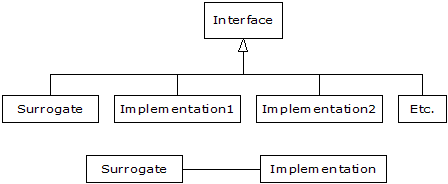SpecialistOff.NET / Вопросы / Статьи / Фрагменты кода / Резюме / Метки / Помощь / Файлы
НазадFronting for an Implementation
Метки: python
Both Proxy and State provide a surrogate class that you use in your code; the real class that does the work is hidden behind this surrogate class. When you call a method in the surrogate, it simply turns around and calls the method in the implementing class. These two patterns are so similar that the Proxyis simply a special case of State. One is tempted to just lump the two together into a pattern called Surrogate, but the term “proxy” has a long-standing and specialized meaning, which probably explains the reason for the two different patterns.
The basic idea is simple: from a base class, the surrogate is derived along with the class or classes that provide the actual implementation:

When a surrogate object is created, it is given an implementation to which to send all of the method calls.
Structurally, the difference between Proxy and State is simple: a Proxy has only one implementation, while State has more than one. The application of the patterns is considered (in Design Patterns) to be distinct: Proxy is used to control access to its implementation, while State allows you to change the implementation dynamically. However, if you expand your notion of “controlling access to implementation” then the two fit neatly together.